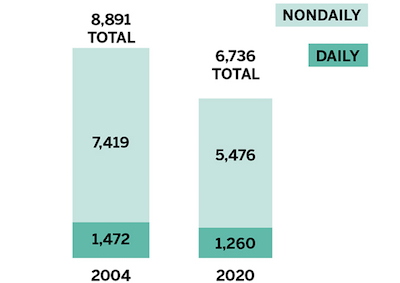U.S. newsrooms have existed in a perilous state for years now, and the effects of the COVID-19 pandemic and ensuing economic recession will only further exacerbate the ongoing decline of the nation’s local media ecosystem.
According to a June report released by the Hussman School of Journalism and Media at the University of North Carolina at Chapel Hill, more than one-fourth of the country’s newspapers have disappeared in the last 15 years, leaving a growing number of American communities without access to local news.
There are 6,736 local newspapers in the United States—1,260 dailies and 5,474 weeklies—that were still being published at the end of 2019. According to the UNC report, this number reveals an astounding disappearance of 2,155 papers from the 8,891 news titles that were being published in 2004, accounting for a loss of approx. 212 daily titles and 1,943 non-dailies.
 Total number of U.S. newspapers: 2004 vs. 2020. Total number of U.S. newspapers: 2004 vs. 2020. |
In the last year alone, more than 300 newspapers across the U.S. shuttered, resulting in a loss of about 6,000 journalism jobs and a print news circulation decline of approx. five million. At least 30 U.S. newspapers closed or merged between April and May 2020 alone, according to the report.
As a result, “news deserts” have spread across the country, leaving more than 1,800 communities in the U.S. without access to local print or digital reporting. About half of the nation’s 3,143 counties have only one newspaper, and two-thirds don’t have a daily. More than 200 of the counties in the U.S. currently have no local news outlet whatsoever. Of the newspapers that have survived, many have now been rendered “ghost papers,” with little original reporting and greatly diminished readership. Only about half of the 1,400 public broadcasting stations in the country currently produce local content, according to the study.
2020 has dealt two once-in-a-century catastrophes—a global pandemic and an economic collapse on par with the Great Depression—which no doubt will result in the continued closure of countless more local newsrooms. Ironically, these events had the effect of driving Americans’ interest in the local news in recent months, as homebound residents across the country eagerly awaited updates on how the COVID-19 pandemic was affecting their communities and what steps state and local officials were taking to respond to the crisis.
“The paradox of the coronavirus pandemic and the ensuing economic shutdown is that it has exposed the deep fissures that have stealthily undermined the health of local journalism in recent years, while also reminding us of how important timely and credible local news and information are to our health and that of our community,” the report’s authors wrote. “This is a watershed year, and the choices we make in 2020—as citizens, policymakers and industry leaders—will determine the future of the local news landscape.”
Hussman School of Journalism and Media’s report, “News Deserts and Ghost Newspapers: Will Local News Survive?” is the fourth installment in a series of reports on the loss of local news published by UNC’s Center for Innovation and Sustainability in Local Media. Findings were based on a survey of all 50 state press associations as well as a proprietary database collected by the Center over the past 15 years, which contains more than 9,000 local newspapers, 1,400 public broadcasting outlets, 950 ethnic media and 525 digital sites.


 Trump Media & Technology Group today reported a $58.2M net loss on $4.1M in 2023 revenues, a disclosure that drove its stock price down 22.6 percent to $47.96.
Trump Media & Technology Group today reported a $58.2M net loss on $4.1M in 2023 revenues, a disclosure that drove its stock price down 22.6 percent to $47.96. Barry Pollack, an attorney at Wall Street’s Harris St. Laurent & Wechsler, has registered Julian Assange as a client with the Justice Dept. “out of an abundance of caution.”
Barry Pollack, an attorney at Wall Street’s Harris St. Laurent & Wechsler, has registered Julian Assange as a client with the Justice Dept. “out of an abundance of caution.” Paramount Global to slash 800 jobs in what chief executive Bob Bakish calls part of an effort to “return the company to earnings growth"... Rolling Stone editor-in-chief Noah Shachtman is exiting at the end of the month due to disagreements with chief executive Gus Wenner over the direction the magazine is taking... The New York Times broke the $1 billion barrier in annual revenue from digital subscriptions in 2023... Press Forward is investing more than $500 million to strengthen local newsrooms.
Paramount Global to slash 800 jobs in what chief executive Bob Bakish calls part of an effort to “return the company to earnings growth"... Rolling Stone editor-in-chief Noah Shachtman is exiting at the end of the month due to disagreements with chief executive Gus Wenner over the direction the magazine is taking... The New York Times broke the $1 billion barrier in annual revenue from digital subscriptions in 2023... Press Forward is investing more than $500 million to strengthen local newsrooms. The majority of news articles are read within the first three days of publication, according to a recent report.
The majority of news articles are read within the first three days of publication, according to a recent report. The Los Angeles Times gives pink slips to 115 people or 20 percent of its newsroom staff... TIME is also laying off about 30 employees, which is approximately 15 percent of its editorial staff... The Baltimore Banner, which was launched by Stewart Bainum in 2022 after he failed to buy the Baltimore Sun, added 500 subscribers per day in the three days following Sinclair Broadcast Group's deal to purchase the Sun.
The Los Angeles Times gives pink slips to 115 people or 20 percent of its newsroom staff... TIME is also laying off about 30 employees, which is approximately 15 percent of its editorial staff... The Baltimore Banner, which was launched by Stewart Bainum in 2022 after he failed to buy the Baltimore Sun, added 500 subscribers per day in the three days following Sinclair Broadcast Group's deal to purchase the Sun.


 Have a comment? Send it to
Have a comment? Send it to 
No comments have been submitted for this story yet.